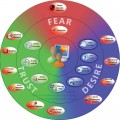I have posted about different scams that take place offline. For example, I have posted about phone scams HERE as well as fake checks I’ve received HERE.
James Murray wrote an article focusing on a few offline identity concerns including people walking by with RFID readers used to copy credit cards and other RFID enabled devices. I talked about the Proxy Mark 3 and other RFID tools on this blog explaining why RFID shields are ideal for your wallet. Here is the guest post from James Murray.
Identity fraud is often considered an online phenomenon. But protecting yourself from identity theft isn’t just a case of creating strong passwords or using antivirus software. The sad fact is, 44% of ID fraud happens when someone’s purse or wallet is stolen, so consumers need to be equally as diligent offline as they are behind the keyboard.
To help you better understand how to protect your personal details from being stolen, and what to do if you become a victim of identity theft, here a some of the most common offline scams to look out for and what to do if you find yourself being targeted by one.
Voice phishing
Voice phishing, also known as vishing, is a type of fraud where criminals try to gain access to your personal information by posing as callers from reputable organisations.
The scammers use clever ID-spoofing techniques that take advantage of VoIP or PRI providers’ pre-call configuration settings to appear like they’re calling from a legitimate number, typically one associated with a bank. This is how they convince victims that the call is genuine.
Using a combination of scare tactics and emotional manipulation, scammers then persuade victims to divulge sensitive information so they can steal their money, identity or both.
To avoid falling foul of vishing scams, it’s important to remember that caller-ID is not an adequate means of identification and that banks and other institutions will never ask you to reveal your account details, even in the case of emergencies. If a caller does ask you to provide details you feel uncomfortable with sharing, it’s best to simply hang up and dial the number on your card or bank statement to verify the authenticity of the call.
Postal Theft
Your mail is a veritable gold mine for potential fraudsters. With key pieces of information like your name and address, criminals can pretend to be you and complete a number of financial transactions in your name, such as opening a bank account or taking out a credit card loan.
Postal fraud is particularly insidious as it can take several months for the bills to arrive. By which time, the fraudsters have already made off with the money and left you in debt.
Every piece of mail contains personal information. So to prevent fraudsters from piecing together your details, never throw out entire bills, receipts or bank statements and if possible, use either shredders or ID-protection stamps to scramble sensitive information before throwing it away.
RFID Digital Theft?
Wallets contain many important details that can be used by thieves to steal your identity. Reports online of digital pickpocketing are widespread, and because of this many now believe that identity thieves can steal your financial information without even touching you. But can fraudsters really steal your credit and debit card information without digging through your wallet?
Contactless payments overtook chip-and-pin as the most common form of in-store payment in June 2018. These transactions use a technology called RFID (Radio Frequency Identification) to transmit digital information between your credit card and credit card readers, and it’s this new technology that fraudsters are supposedly exploiting.
There are plenty of accounts online about digital pickpockets and how they can download your credit card details by simply bumping into you on the street. But in truth, not a single incident of someone stealing money using this technique has been confirmed. In actual fact, the myth is being peddled by companies looking to take advantage of consumer misinformation and make money out of selling RFID-blocking products.
Specially designed RFID-blocking wallets and backpacks are everywhere now, and are said to work by blocking the high-energy frequencies emitted by readers. But where credit cards transmit a one-time encrypted transaction code and don’t provide your name, billing address or, more crucially, the three-digital code on the back of your card, harvesting information this way just isn’t worthwhile for digital pickpockets.
The true danger of contactless is when someone steals or finds your card and then uses it to make contactless payments. So the best way to prevent this type of fraud is to either request a chip-and-pin card from your bank or report your card lost or stolen as soon as your realise it’s missing.
According to research conducted this year, over one quarter of UK consumers have been affected by identity theft. Worse still, the same study also revealed that 50% of those affected found it difficult to resolve the issue.
With so many cases of identity fraud being reported each year, it’s important to remain vigilant and protect your personal information both on and offline. Simple ways to do this involve securing your home with a post box or cowl visor guard, shredding your mail and keeping up to date with latest RFID-related crimes.



